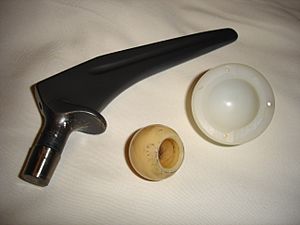Cermet facts for kids
A cermet is a special material that mixes a ceramic (like porcelain or clay) with a metal (like steel or copper). Think of it like a super-strong team-up! These materials are very tough, last a long time, and can handle a lot of pressure. They also create very little friction.
Cermets have some cool properties from both ceramics and metals. They can conduct electricity, just like metals. They are also a bit bendable or shapeable. The main idea behind cermets is to get the best qualities from both materials. For example, ceramics are great at resisting high temperatures and are very hard. Metals, on the other hand, can bend and change shape without breaking.
In a cermet, the metal acts like a glue, holding together tiny particles of an oxide, boride, or carbide ceramic. The metals often used are nickel, molybdenum, and cobalt. Even though they have metal, cermets usually have less than 20% metal by volume.
You can find cermets in many places. They are used to make resistors and capacitors in electronics, especially in parts that get very hot. Some cermets are even being looked at for spacecraft shielding. They can protect against tiny space rocks and space junk much better than regular metals like aluminum.
Contents
History of Cermets
After World War II, people needed new materials that could handle very high temperatures and a lot of stress. German scientists started working on cermets made from oxides. They thought these materials would be perfect for hot parts of new jet engines, like the turbine blades. Today, ceramics are often used in the combustion part of jet engines because they can handle the extreme heat. Ceramic turbine blades have also been made. They are lighter than steel blades, which helps the engine speed up faster.
The United States Air Force saw how useful cermets could be. They became a big supporter of research programs in the US. Some of the first universities to study cermets were Ohio State University, University of Illinois, and Rutgers University.
The word "cermet" was actually created by the US Air Force. It combines "ceramic" and "metal" because that's exactly what these materials are! Metals are known for being strong, bendable, and good at conducting heat. Ceramics are known for having a high melting point, being chemically stable, and resisting rusting.
The first ceramic-metal materials used magnesium oxide (MgO), beryllium oxide (BeO), and aluminum oxide (Al2O3) as the ceramic part. Scientists wanted them to be strong at temperatures around 980 °C. Ohio State University was the first to make Al2O3-based cermets that were strong even at 1200 °C.
A company called Kennametal developed the first cermet made with titanium carbide. This material was strong enough for jet engine parts, which operate at about 980 °C.
However, it was hard to make these ceramic-metal composites consistently. The quality could vary a lot, even in small batches. If there were tiny hidden flaws from the manufacturing process, the material could fail. Because of these challenges, engine makers were slow to use cermets in the 1950s.
Interest in cermets grew again in the 1960s. Scientists started looking at silicon nitride and silicon carbide. These materials were better at handling sudden temperature changes, were very strong, and conducted heat moderately well.
Where Cermets Are Used
Cermets are used in many different ways because of their unique properties.
Joining Ceramics and Metals
One of the first big uses for cermets was in connecting ceramic parts to metal parts. This was very important in making vacuum tubes for the electronics industry. German scientists found that vacuum tubes made with ceramics instead of glass worked better and lasted longer. Ceramic tubes could handle higher temperatures and were stronger. Today, cermet coatings on vacuum tubes are even used in solar hot water systems.
Cermet seals are also used in mechanical seals. They help keep electrical parts separate in devices like fuel cells that turn chemical or heat energy into electricity.
Bioceramics in Medicine
Bioceramics are special cermets used in the human body. Scientists have developed many different types and ways to make them. They can be thin layers on metal implants, mixed with polymers, or even porous structures. These materials work well in the body for several reasons. Some are inert, meaning they stay unchanged. Others are resorbable or active, meaning they can dissolve or even help with body processes. For example, hydroxylapatite is similar to bone and can help new bone grow into it. Common bioceramics include alumina, zirconia, and calcium phosphate.
A very important use of bioceramics is in hip replacement surgery. In the past, hip joints were often made of metals like titanium, with a plastic lining. The ball part of the joint was a tough metal. But later, a longer-lasting ceramic ball was used instead. This helped reduce wear and tear between the metal and plastic, making the hip replacement last longer.
Cermets are also used in dentistry for fillings and other dental parts.
Transportation Uses
Ceramic parts combined with metal parts are used as friction materials in brakes and clutches in vehicles.
Other Cool Uses
Both the United States Army and the British Army have researched cermets a lot. They have used them to develop lightweight, bulletproof armor for soldiers. Cermets are also part of advanced vehicle armor like Chobham armor.
Cermets are also used in machining for making very strong cutting tools.
You can also find cermets as the ring material in high-quality line guides for fishing rods.
See also
 In Spanish: Cermet para niños
In Spanish: Cermet para niños


